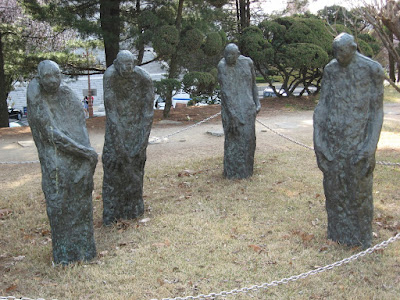My initial response was, what traffic signs?
Well, okay, they do have have traffic signs, at some intersections, but mostly they just suggest which directions you can turn. And I say "suggest" pointedly. There are no stop signs, though tricky intersections may have a convex mirror so drivers can see what's coming.
As if to confirm the Times' xenophobic editorial stance, the story states, "The measure reflects complaints from foreigners here that Korea's different traffic signal system for automobiles confuses visitors."
The real reason, fortunately, is also provided:
The green-amber-red system used by most advanced countries will help save up to five trillion won in taxpayers' money annually in dealing with accidents, air pollution and carbon emissions, the committee said. ...
The committee forecast that, if the system is introduced, cars will run faster on downtown streets in cities, and the risk of accidents will be reduced for both cars and pedestrians.
Speaking of pedestrians, a second article announces that "Walking Directions Will Be Switched to Right."
The National Police Agency said it will seek to revise related traffic law to switch the walkers' direction to the right side. The current law stipulates that people should walk on the left side of a road without sidewalks.
The authorities appear to have used actual scientific studies to determine that people are more comfortable, therefore safer, walking on the right. Right-handed people, that is ...
The article tags Koreans as 88% right-handed, suggesting that 12% are lefties, like myself. Now, that number fits with the human population at large (I remember having one of my physical science classes at Heritage do a survey on handedness among all two hundred-plus students for FrEdMail, and getting right at 10%) but it is not borne out by my casual observations at Young-il.
I teach 785 or so students this semester and I have counted their handedness by observing which hand they use to write with--not a perfect methodology, I admit: A) they're a selected group, as you pay to go to high school here; B) they're all boys; and C) writing is a good measure of handedness, but not inerrant (batting, throwing, etc).
Still, the result is telling: 11. That's 1.4%, in a sample size that should yield about one percent error in a properly randomized sample, as Korea's population is only 50 million.
Anyway, the curious history of the left/right rule is provided:
During the Joseon Kingdom (1392-1910) era, regulations stated that people and carriages keep to the right, but it was changed in 1921 to put Korea in line with Japan where cars keep to the left.
After Korea was liberated from Japanese colonial rule, the U.S. authorities changed the regulation again by putting cars to the right, while maintaining that pedestrians keep to the left. The Korean government followed suit when establishing the law on road traffic in 1961. It was applied only to roads without sidewalks so that pedestrians could face oncoming cars, but the rule has been adopted as a custom in other public facilities such as the subway system.
Bonus Photograph: Here's a shot of traffic on the main road where my bus stops when I come home from anywhere, taken two weeks ago.


























































